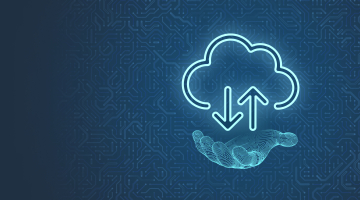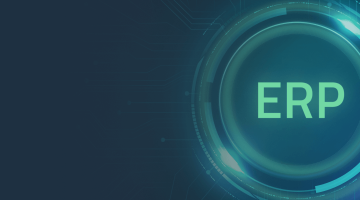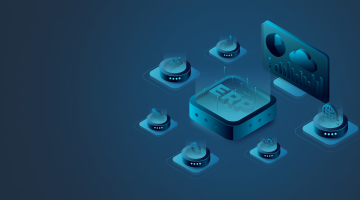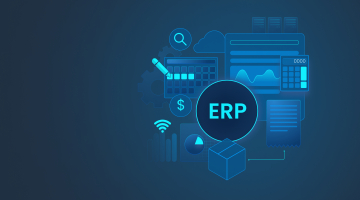

ERP vs. CRM: Benefits and disadvantages of each solution
For any modern enterprise with big-time aspirations, using professional software solutions is not a whim but a bread-and-butter necessity. They streamline and facilitate the lion’s share of routine business processes, coordinate performance across multiple departments, speed up sales cycles, and allow companies to improve customer service dramatically. Among dozens of business software products, ERP and CRM systems are rightly considered the backbone of the professional IT infrastructure.
This article will explore the essence of ERP and CRM software, highlight the features and benefits of each solution, pinpoint the major differences between them, and offer advice on choosing an ERP or CRM system for your digitally driven business.
ERP software explained
ERP stands for enterprise resource planning – a suite of tools honed for managing organizations’ day-to-day pipeline business operations. It is an upgraded version of MRP (material requirements planning) – an earlier solution employed by manufacturers to monitor and administer all resources they need to keep their business running smoothly. Today, having evolved into multi-functional platforms, ERP systems serve as centralized hubs with a shared database, helping enterprises streamline operations and revolutionize internal workflows.
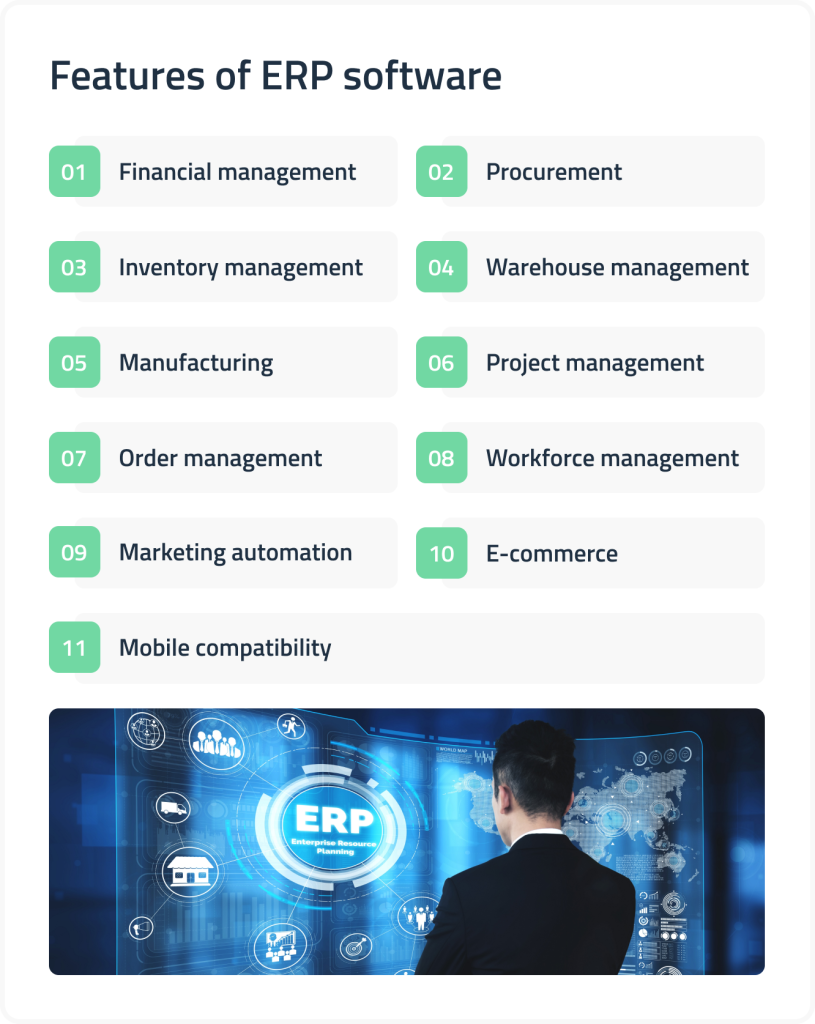
The scope of functions an ERP performs is enabled by the key features of this solution.
- Financial management. Usually, an organization’s finance teams account for its current financial state and future prospects in this sector. Thanks to ERP, they can create vital financial documents (tax statements, balance sheets, payment receipts, and the like), track accounts payable and receivable, conduct billing, and manage the general ledger. Besides, financial data stored in the system is used in the preparation of reports, financial planning, and BI initiatives.
- Procurement. This module helps organizations manage their purchasing routine and ensure the ceaseless influx of products or materials they require to manufacture or sell goods. It supports effective supply chain management by helping the company stay in touch with vendors and suppliers, automate quote requests, send out purchase orders, and ship products.
- Inventory management. Typically, it works in sync with the procurement tool. It provides a complete picture of both current and incoming inventory across multiple locations and ensures constant availability of materials and goods. The overarching goal of this tool is to prevent stockouts and avoid overstocking.
- Warehouse management is closely related to the two previously mentioned modules. Its purpose is to ensure efficient storage space utilization, allow personnel to quickly find necessary products, and speed them on their way to manufacturers or customers. To optimize the process, the functionality leverages wave picking, batch picking, zone picking, and other product handling techniques.
- Manufacturing is relevant for companies that produce various goods. Employees utilize this capability to track output against anticipated production, calculate the time required to produce each item, capture information on products being manufactured at any given moment, as well as finished goods, and provide a real-time view of the shop floor.
- Project management. Unlike the module above, this one is meant for service-oriented businesses. Also known as service resource management, the feature tackles end-to-end project management, including project status tracking, financial and workforce resource allocation, billing automation, and providing seamless interaction between departments and teams.
- Order management. This functionality helps handle orders coast-to-coast – from order receipt to item delivery. Thanks to it, goods are shipped on time and never get lost, which guarantees higher customer satisfaction.
- Workforce management. Acting as a kind of CRM for employees, this module is responsible for managing an organization’s human resources. Alongside serving as a centralized system for storing personnel data and performance reviews, it also offers job descriptions, monitors staff attendance, tracks the amount of working time, distributes paychecks, deducts taxes, etc.
- Marketing automation. Thanks to it, sales and marketing teams can conduct granular customer segmentation, launch targeted marketing campaigns across multiple digital channels (email, social media, SMS, messenger apps, you name it), and obtain detailed reports on their efficiency. This allows managers and sales representatives to make changes in these channels, thus increasing customer engagement and fostering brand loyalty.
- E-commerce. Geared towards online B2B or B2C companies, this feature allows them to update product content on their site, add new items to the roster, customize the e-store’s design, and perform other business functions an e-commerce venture requires for successful operation and providing excellent customer experiences to their clientele.
- Mobile compatibility. If an organization consists of a ramified network of branches and storefronts strewn over a sizable area, the portability of the ERP system is a non-negotiable feature. It will allow employees across remote locations to enjoy the same capabilities and coordinate efforts for the common cause.
Given the multitude of functions ERP solutions perform, onboarding such software ushers in weighty boons for organizations.
Zooming in on the perks of ERP solutions
Having vast experience in developing and implementing custom ERP systems, we at DICEUS know what companies get by harnessing them.
- Augmented efficiency. ERP’s ability to automate repetitive tasks (data entry, resource allocation, order tracking, and more) across departments accelerates all workflows and spares personnel monotonous assignments, allowing them to focus on more creative and complex errands and increasing the organization’s overall productivity.
- Error reduction. When machines tackle various shop floor tasks, they do so accurately and quickly, avoiding errors that are symptomatic of human workforce performance.
- Cost saving. An across-the-board utilization of automation minimizes the need for human personnel, thus optimizing operational expenditures and providing additional financial resources for embracing innovation within the organization.
- Real-time updates. All business data entered into the system is updated 24/7, allowing managers, sales reps, and other staff to have the latest information at their fingertips and plan their actions accordingly.
- Knowledgeable decision-making. ERP serves as the single source of truth that provides a 360-degree view of all internal processes within the organization. Managers can analyze data provided by business intelligence tools ERP contains and come up with insight-driven decisions concerning all aspects of their company’s business management – from customer demand and sales forecasting to budget planning and customer retention.
- Improved collaboration. A constantly updated and consolidated database and a common interface an ERP provides enable all employees to exchange information freely and work together on various assignments requiring joint effort, thus promoting transparency of workflows across the organization and ruling out data silos.
- Cyber protection and risk management. An ERP’s advanced security mechanisms (permission-based access, data encryption, automatic backups, and more) prevent unauthorized access to sensitive information, improve audit trails, and minimize operational and financial risks.
Sounds like an ERP system is the ultimate product that provides everything a business might need in its digitalized shop floor activities? No. Because it doesn’t cover a mission-critical aspect of any commercial organization’s functioning – its client-facing workflows and customer relationships. And this is where CRM solutions step in.
Meet CRM software systems
Customer relationship management (CRM) is a solution responsible for managing customer data and promoting customer interactions with the organization. Initially honed for sales teams as sales force automation (SFA) systems, CRMs today are comprehensive platforms that help personnel across all departments with client data management and customer communications as well as streamline and facilitate customer service processes.
What are the typical features of a CRM solution?
- Customer information and content repository. This is the bedrock of the system, where all clients’ names, addresses, and contact data are stored, allowing customer service representatives and other personnel to get in touch with the person or organization they need. Plus, they can find there all the images and documents related to the company’s workflows.
- Lead management. Here, all information on people’s purchase history and previous contacts with them is accumulated. It is updated in real-time to let employees assess the current status of leads and ongoing sales operations with them.
- Marketing. This module stores exhaustive information on past and current marketing campaigns with respective KPIs (click-through rates, conversion rates, etc.) to evaluate their efficiency and fine-tune your future marketing efforts correspondingly.
- Customer support. Exceptional customer service is the name of the game in modern business, and CRM gives customer service teams all the opportunities to provide it. It ensures clients can solve their problems as soon as possible, with no outstanding customer service tickets left unattended, and/or receive answers to all their queries in a New York minute.
- Workflow automation. The majority of pipeline activities related to customer interactions can be automated, including assigning tasks to personnel, nurturing leads, running marketing campaigns, and more.
- Reports and analytics. Integrated tools allow for in-depth customer data analysis and generate customized reports on workforce performance. These reports give managers valuable insights into problem zones and outline prospects for improvement.
- Third-party integrations. Through a set of APIs, CRM is connected with various external apps, customer service solutions, social media, SaaS resources, and other systems, thus enhancing its capabilities.
What are the assets of onboarding CRM systems?
CRM benefits highlighted
A robust CRM ushers in the following business perks.
- Boosted productivity. With numerous pipeline processes automated, personnel can solve their tasks faster and accomplish more within their working time.
- Standardized workflows and sales pipelines. CRM allows employees across the entire organization to follow the same routine while performing their responsibilities, ensuring identical level of services at all touchpoints.
- Improved lead generation and nurturing. Having all customer-related data (demographics, preferences, past transactions, interactions, you name it) at their disposal, your employees can find a personalized approach to each client, offering them products and services they are sure to enjoy and turning leads into loyal customers and even brand advocates.
- High-quality insights. CRMs’ advanced analytics tools provide a wealth of data-driven insights into the organization’s functioning in general, enabling strategic decision-making and elevating long-term planning to a new level.
- Enhanced customer service. Knowing their clients inside out, customer support specialists can provide faster responses to queries and radically improve the customer satisfaction people get from interacting with the brand.
After exposing the capabilities of CRM and ERP software, it makes sense to compare them head-to-head.
Similarities and differences between CRM and ERP systems
The two solutions have something in common. They are both leveraged by enterprises as relational databases, allowing personnel to store and analyze data. Both systems can be installed as on-premises applications or delivered as cloud-based SaaS products. And both help organizations to improve efficiency, promote automation, and boost revenues. Then, can ERP replace CRM or vice versa? Not really. Their fundamental differences lie in usage.
ERP systems are utilized by all units of an organization (primarily, the financial department, but not only), serving as a second-to-none tool for supporting multiple back-office workflows (accounting, supply chain management, HR, inventory handling, order fulfillment, and the like).
CRM solutions have a different focus. They are employed to manage client-facing functions (sales, marketing, customer support), which are the responsibilities of sales and customer service teams. Thus, their basic use cases are related to managing communications with the clientele, converting leads to customers, and automating transactions across multiple touchpoints.
Simply put, ERP is geared toward organizing internal pipeline activities and improving cooperation between departments, whereas CRM’s gaze is bent outwards to streamline and facilitate a company’s interactions with customers.
Evidently, one system can’t replace the other. But how to choose a platform for your company that will bring maximum value to it?
ERP vs CRM: Opting for the right solution
Both systems are essential for an organization’s business success and income generation. Yet, sometimes, a company can’t afford onboarding both solutions, so it has to choose one platform over the other, at least for the time being. In such a case, the question is not “Which platform is preferable?” but “Which one can you not do without?” To answer it, you should look into your company’s needs.
If yours is a startup on short commons or a small-sized business, providing seamless collaboration between departments is irrelevant, simply because you don’t have any departments and a small staff of professionals manages all shop floor activities. Or your teams may not depend greatly upon each other to finalize deals or administer campaigns. For such enterprises, an ERP has minimal value, so a CRM will be a sound choice. The latter system is also a natural initial investment for organizations with straightforward financial operations and a sizable customer base requiring regular interactions.
As your financials get more complex with the organization’s expansion or your company’s business is centered around an established set of high-value partners and customers, it is time to implement ERP software. The same consideration applies if such a business model is your starting point.
The current business objectives can also condition harnessing a certain system first. If what you aim to achieve at the present stage is business growth enabled via robust lead generation, high conversion rate, seamless customer journey, and brand awareness, think CRM. But when you crave harmonization of internal workflows as a major goal, ERP is just what the doctor ordered.
Naturally, picking one when two are better is not what anybody enjoys. Can you have both without paying through the nose?
CRM and ERP integration: An ideal option
Since there is no unquestionable winner in the CRM vs ERP debate, it makes sense to combine both to get the best of both worlds. Is it possible? It is. ERP and CRM integration is implemented by including a CRM module into a bespoke ERP platform. How does such a combo benefit the organization?
Typically, a customer’s interactions with the brand occur across multiple touchpoints managed by various departments and teams. For instance, as soon as a buyer pays for the product online (a front-office operation), information about the transaction enters the back-office system to be further used by the financial department, order management system, and inventory control module. Or, a sales rep needs a customer’s purchase history to know what upselling or cross-selling options to offer them. To deliver a consistent customer experience and harmonize back-office and front-office workflows, employees of different departments must be on the same page and share all relevant data within a common database.
By equipping your ERP solution with a CRM feature (and thus paying for one solution only) you maximize the efficiency of your professional ecosystem and receive a multi-purpose platform for managing all pipeline operations (both front-office and back-office). And DICEUS can become your trusted partner in this endeavor.
We have been present in the IT outsourcing market for over 14 years, during which we have been specializing in crafting custom enterprise solutions for retail, insurance, fintech, logistics, healthcare, and other verticals. Our qualified and certified experts possess enormous experience and versatile hands-on skills to create bespoke CRM solutions and ERP systems (or a balanced combination of both) to satisfy the most demanding customers and complex technical requirements. Contact us to obtain robust professional software of high quality at an affordable price.
Estimate project costs
Please share more details of your project with our team.

Key takeaways
ERP and CRM solutions are two central pillars on which the efficient functioning of modern, digitally-driven enterprises rests. Enterprise resource planning is a comprehensive suite of tools that enable vital workflows within an organization, including procurement, inventory and warehouse management, manufacturing, finances, project and order management, marketing automation, HR, and more, across any business field. Customer relationship management software is honed for handling client-facing tasks related to contact information database, customer support, lead generation, etc.
Both systems improve employee performance, efficiency, and productivity, reduce errors, automate repetitive tasks, and enhance decision-making by providing data-driven insights. The choice of software to onboard depends on the organization’s size and current business objectives. Companies can enjoy the assets of both systems if they delegate the development of a bespoke ERP with an integrated CRM module to a vetted IT vendor with in-depth expertise in building such products.
Frequently asked questions
What is the difference between ERP and CRM systems?
An ERP system encompasses a large scope of functionalities related to back-office operations (HR management, inventory control, order fulfillment, accounting, and more), benefiting financial departments most. A CRM’s primary focus is the front-office routine. It is mostly employed by sales and customer service teams to streamline and facilitate brand-customer interactions and increase conversion rates.
How does an ERP system benefit business operations?
By making an ERP solution a part of their IT infrastructure, organizations boost their efficiency, increase productivity, reduce human-related errors, get access to real-time updates, reduce OPEX, automate multiple repetitive tasks, enhance decision-making, boost collaboration across departments, and improve cyber security of the ecosystem and safety of data it contains.
When should a business choose ERP over CRM?
Usually, when your company is large enough to contain several departments that require harmonious functioning and seamless collaboration, ERP will bring you more value than CRM. ERP is also preferable when your organization has a limited number of time-proven high-value customers that don’t need frequent interactions or constant nurturing.
Can ERP and CRM systems be integrated, and what are the benefits?
You can enjoy the best of the two worlds by including a CRM module in your custom ERP system. Such a synergy will allow your employees to share a consolidated database containing all relevant information, handle the entire scope of back-office and front-office shop floor operations, and provide a consistent customer experience across multiple brand-client interactions.
